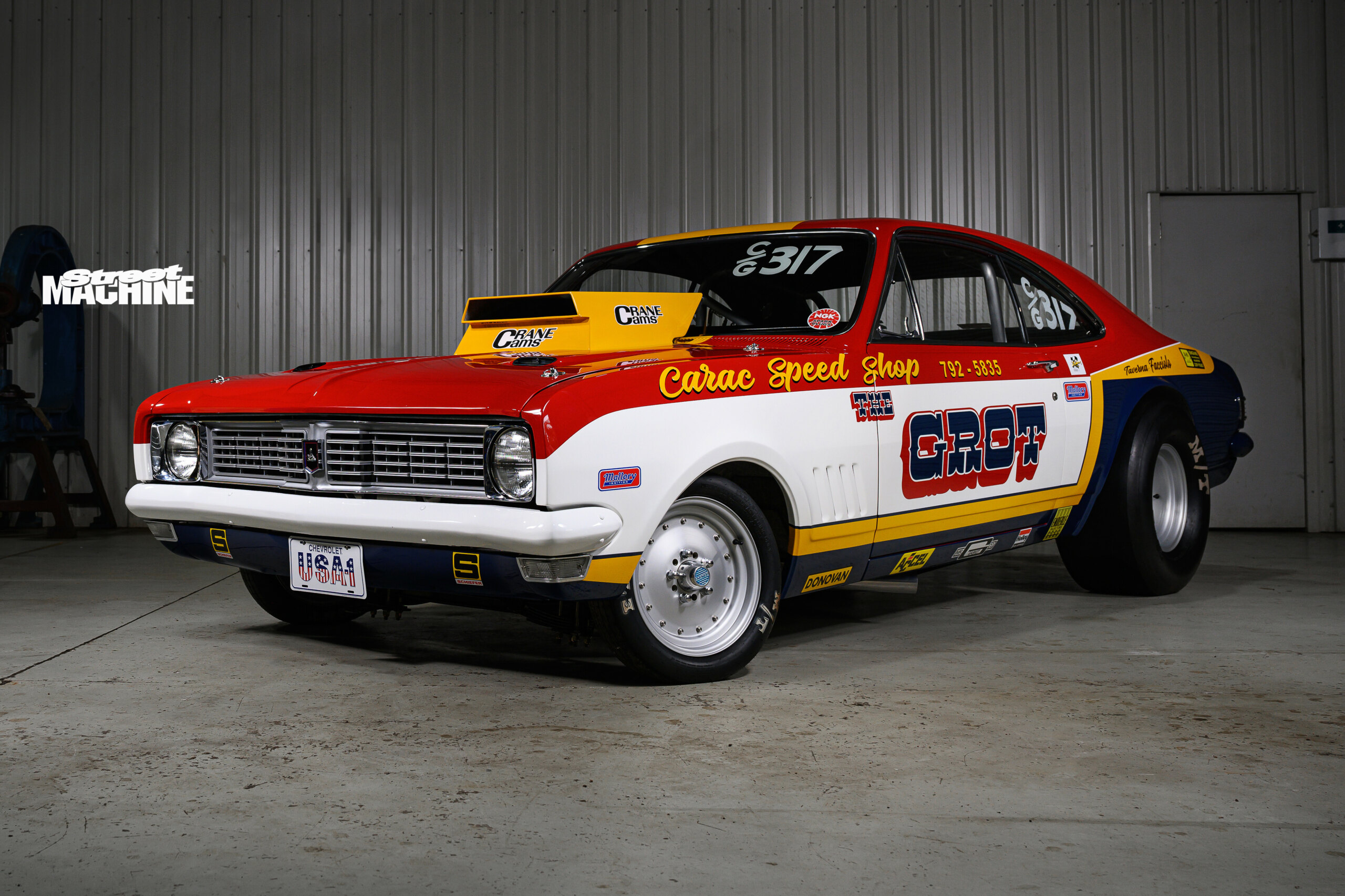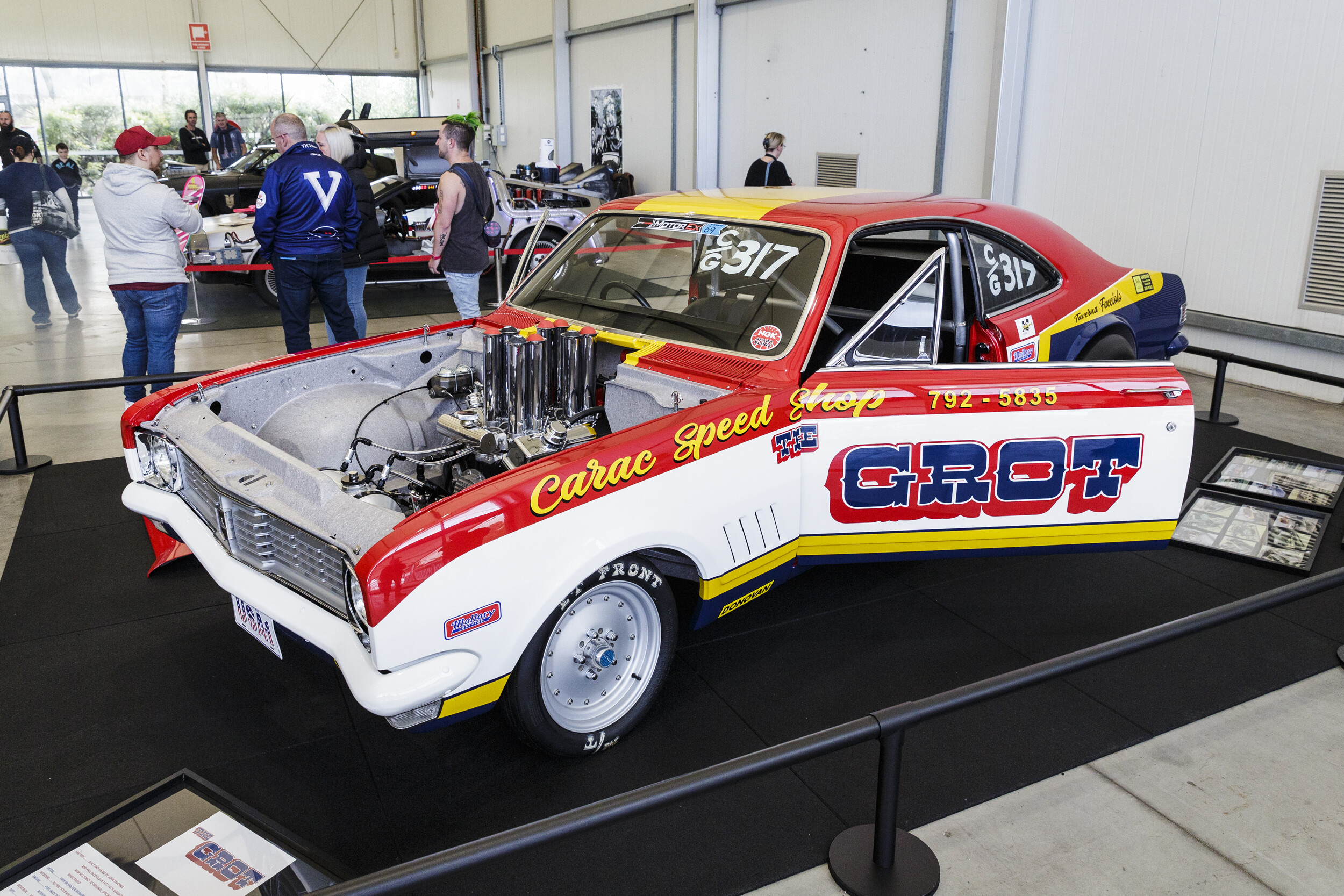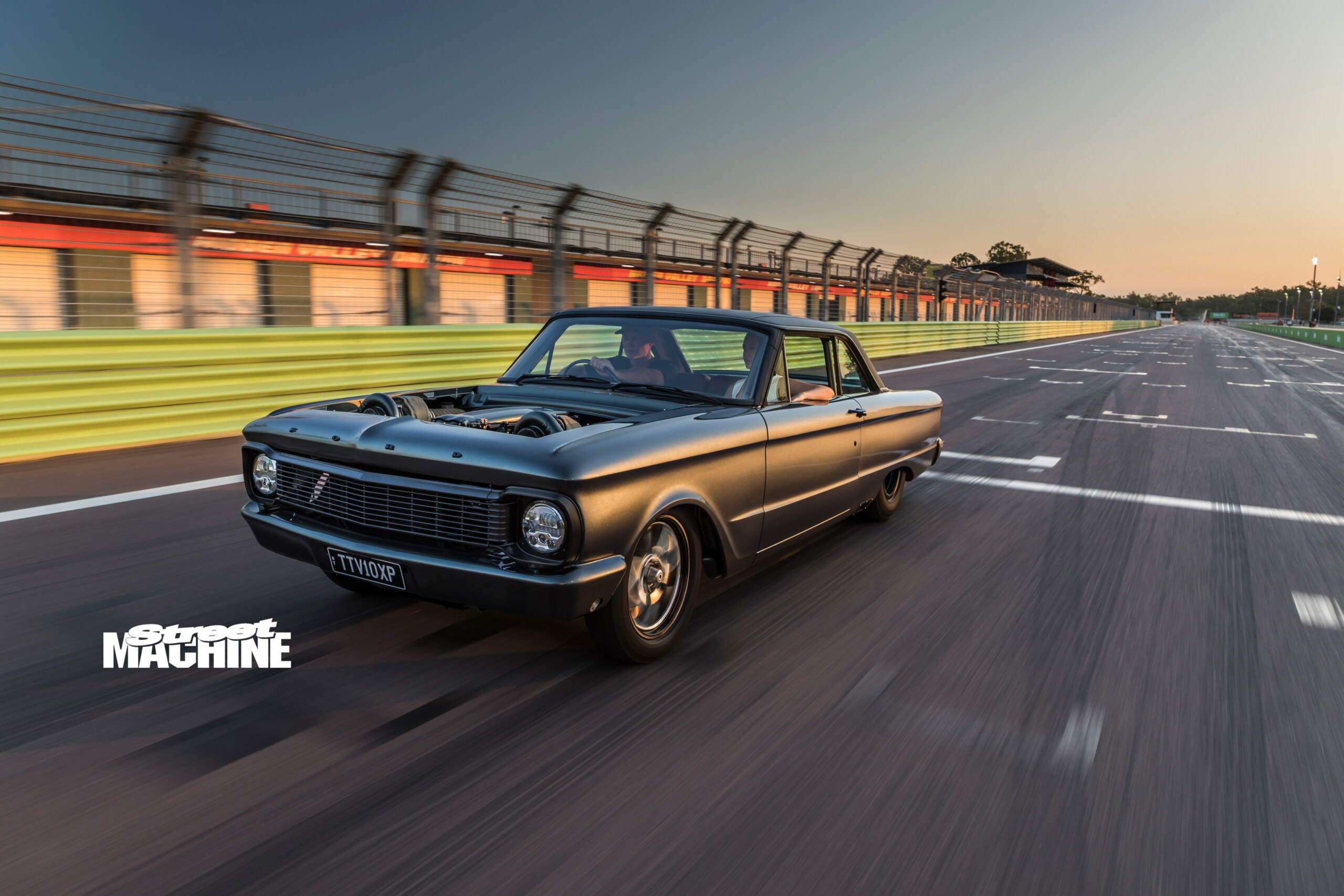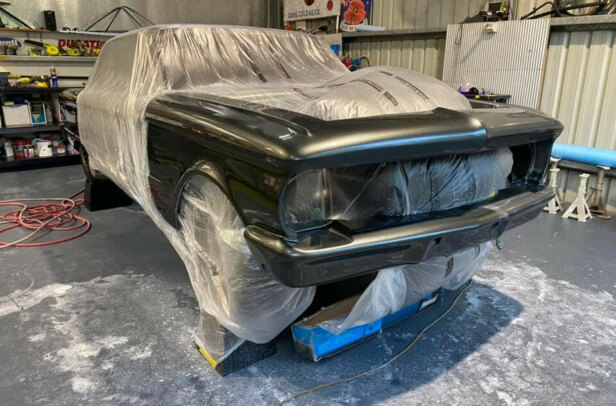It’s long been said that it’s easier to modify a car than to carry out a factory-perfect concours restoration. So, melding the two by undertaking a concours resto of an already-modified car presents a whole new level of difficulty. You’d have to contend with a lack both of benchmark original cars and purist know-alls to tap into for detailed information, compounded by the mystery of parts used or specifications that might only be known to a few people.
It’s a seriously daunting task, and it would be easy to let the details slide given that 99.99 per cent of people would be none the wiser.
First published in the November 2022 issue of Street Machine
Fortunately, Dean Prodger, who hails from McKees Hill, south-west of Lismore, has both the tenacity and the exacting perfectionist’s streak required to restore one of Australia’s most iconic drag cars: the wild HK Monaro known as ‘The Grot’.
“The Grot was raced by the late John Taverna and mate Phil Facciolo in the 1970s, and followed on from their forerunner FJ version,” Dean explains. “John of course went on to become a drag racing and street machining icon, with many well-known cars scoring work at his John Taverna Chassis premises throughout the years.
He and Phil continued their partnership with the Monaro and raced it successfully for a couple of years. It was a crowd favourite for its aggressive launches and big-rpm runs.”
Restoring such a treasured piece of racing history is a mammoth undertaking; fortunately, Dean is no shrinking violet when it comes to tackling big projects. An ace panel-and-paint man, he has been delivering the goods for years through his business, Deano’s Restorations. “I’m a Monaro man too, having owned a number of HK-T-Gs over the years,” Dean says. “My business nowadays is supplying repair panels and the like for the restoration of these models, so I have a pretty thorough knowledge of what makes them tick.”
Dean had to draw on all of that knowledge and then some when he spied the remains of The Grot for sale on eBay back in 2009. “It was advertised in Brisbane as an old drag car from the 70s. I didn’t know of the car, but I recognised one of the old owners’ names – John Taverna. I won the auction for $1600, but to be honest I bought it purely for any useable parts.
“The seller included plenty of research on The Grot, including magazines and photos, and I soon decided I had to restore the car to ensure it wasn’t yet another piece of Aussie racing history that would be lost.
It was completely stuffed and considered beyond repair by many, and I knew from the outset it was going to be a herculean task.”
The seller had bought the remains a few years earlier from brothers in Ballarat, who were originally planning to use the car to re-roof a Monaro convertible. However, that project never eventuated, and The Grot’s bodyshell languished outside for the next 20-plus years. “That probably explains why the car was so rusty,” Dean says. “It was that bad, it was slated to be used as landfill!”
From what Dean has been able to work out, he is the HK’s fourth owner since John sold it as a roller out of the back of Drag News magazine in 1979.
“Early on, I was lucky to speak at length with both John and Phil, who were able to fill in many blanks and took a great interest in the project,” Dean says. “This, along with John’s untimely passing in 2013, really spurred me along to give the rebuild the quality it deserved. I knew that I owed it to both John and Phil to keep this piece of Aussie-built gasser history alive.”
Being in the trade, it was only natural that Dean would tackle the all-steel body and paint himself. “I thought it was best to use a decent donor floorpan out of another HK to form a solid base; I needed to ensure it would be structurally sound to be safe to race again,” he explains. “I built a dedicated jig and literally unpicked the body, panel by panel, individually blasting each piece and then fixing them or hand-making any repair sections as needed. This included not only the rear quarters and turret, but all of the gutters and internal structures that support these panels.”
When it came to missing panels like the bonnet, which featured a one-off steel scoop, Dean fabricated a new scoop using various photo angles as points of reference to get it as close as possible.
The foundation paint and multicolour graphics were also handled by Dean, again using photos for reference along with measurements taken from some surviving paint layers uncovered in the early stages.
COVID lockdowns thwarted Dean’s plans to have paint legend Rick Pacey recreate The Grot’s original signage, so he again took care of that himself using various masking and stencilling techniques. “Most of the speed equipment stickers were found on eBay or sourced from the US, while Pegasus Screenprints in Lismore recreated others, again from scaling photographs of the car back in its heyday.”
The HK’s driveline was long gone, having wound up in John Taverna’s subsequent ‘The Grot’ Torana, but Dean was adamant the car be kept as era-correct as possible while being mechanically strong and reliable enough to handle strip action.
“Originally, I planned to build a small-block Chev similar to what John and Phil had explained to me, destroking to 302 cubes using a 283 crank,” he says. “But I saw a freshly built 383 stroker engine for sale that ticked many of the key visual cues that I needed to emulate.
It was built using a 010, four-bolt 350 block with cast-iron Bowtie heads and old-style Enderle mechanical fuel injection, so it externally looks identical to what The Grot ran in the 70s.”
The internals are a little more modern, though, with a Scat rotating assembly achieving the extra cubes while a solid camshaft and methanol-thirsty 13.2:1 JE pistons help it make the right noises. Dean and his dad, Terry, have a speedway background, so they made easy work of installing a Grot-spec gear drive and cam-driven Enderle 80A mechanical fuel pump.
The mill is estimated to be making around 525hp, so finding a clutch and transmission to handle it reliably was the next port of call. “The Monaro lunched a few Muncies in its heyday with less horsepower, but my addictive need for at least visual accuracy ruled out a non-matching upgrade,” Dean says. “I ended up going with a specially built M23 ‘Super Muncie’, which is a beefed-up version of the original ’box made in the US by Craig Wright at Auto Gear.”
A nine-inch housing was filled with a 35-spline full spool and Moser axles, along with short 4.72:1 gears to best suit the 31in-diameter slicks. The diff is suspended on original GTS leaf spring packs, while 11-inch Ford finned drums provide the only stopping power for when the fun part is over (the front runs without brakes).
The rear may be pretty standard fare, but the front was where anything factory went out the window: “I knew it ran a solid beam axle originally, but I was stuffed if I knew its origin,” Dean says. “I posed the question to John Taverna early in the build and he quickly said, ‘1934 Chev.’ So I sourced one and it slipped straight onto the small, ex-trailer leaf springs.”
While there’s no stoppers up front, the steering has been upgraded with the same custom rack-and-pinion set-up from The Grot’s early days.
Wheel choice can make or break any build, especially when they form such an integral part of a vehicle’s historical appearance. The Grot’s original Cragar Super Trick rims were long gone and ceased production years ago, so it was back to hunting for second-handies in the US.
Dean came up trumps sourcing Grot-specific 15×3.5 front-runners in HQ/Chev pattern, and 5in-PCD, 15×10 F100 rears. These received the Deano’s Restorations magic touch before being wrapped in fresh Mickey Thompson 22.5×4.5 and 31×11.5 rubber respectively. “Sometimes it’s the little things that provide the biggest hurdles,” Dean says. “The wheel centre caps, for example, were especially hard to find and expensive; then I had to restore them as well.”
The interior is pure 1970s C/Gas spec, the regulations of which required factory-style carpet and door trims but allowed for rear seat deletion. An era-correct sports steering wheel, harnesses and front race buckets are shrouded by an aluminium half rollcage. The engine action is monitored by a tacho and an oil pressure gauge.
After an intense build, the reborn Grot was unveiled at this year’s MotorEx to the delight of many, including the car’s original part-owner Phil Facciolo and John Taverna’s son, John Jr. “I was overwhelmed by the response,” Dean says. “The positive reception of the HK was very humbling, and the number of people who remembered the car from its heyday or had followed its build just blew me away.
“I can’t wait to stretch its legs now at a Nostalgia meet. The plan is to do some non-competitive exhibition passes, but that’s not to say I won’t be giving it plenty of stick – hey, it’s only semi-retired!”
Here comes trouble
The Grot’s restoration wasn’t without dramas, both in and out of the shed. The enormity of the project wasn’t lost on Dean, and in the early stages he found that progress ebbed and flowed. “I’d get a run on things but then get sidetracked with family and work commitments,” he says. “Then I’d chat with John or Phil or have some random person contact me with information about the car, and I’d be reinvigorated.”
However, the difficulties piled up in the last 18 months of the project. Dean’s wife of 26 years, Susan, was diagnosed with cancer, which obviously belted his family for six.
Helping care for Susan while raising two teenage daughters and running a one-man business had Dean burning the candle at both ends, but he would find some stress relief tinkering with the Monaro, which kept the project moving.
“Thankfully, Susan has pulled through and is in remission, but at the time I would feel guilty working on The Grot,” he recalls. “However, the time-out would help me reset my brain to stay properly focused on our family.”
The final blow came with the car all but finished and booked in to be displayed at this year’s MotorEx. Lismore and its surrounds were hit badly by record-breaking floods, and The Grot nearly fell victim. “I thought the car would be safe in the workshop, but the water kept rising at a record pace and it got too late to move it to safer ground,” Dean says. “My hoist was jammed full of an immovable project, so I just jacked
The Grot as high as possible on stands and hoped for the best. I didn’t sleep a wink that night and couldn’t bear to even wade down and look into the shed window.”
Even with the car jacked up high, the water still reached the sills, but thankfully no significant damage was sustained.
After a detail underneath, The Grot was show-ready and went on to be one of the stand-out cars at MotorEx 2022.
GROT TO TROT
‘The Grot’ name was originally used for a Taverna/Facciolo Chev-powered FJ (above). Then the Monaro (below).
And later John’s own full-chassis LX Torana race car (below).
DEAN PRODGER
1968 HOLDEN HK MONARO GTS
| Colour: | PPG white, PPG custom graphics |
|---|---|
| ENGINE | |
| Make: | Chevrolet 383ci |
| Block: | Factory cast 010 four-bolt |
| Crank: | Scat stroker |
| Camshaft: | Solid flat-tappet |
| Pistons: | JE 13.2:1 |
| Intake: | Enderle |
| Induction: | Enderle mechanical fuel injection |
| Exhaust: | Custom extractors |
| SHIFT | |
| Gearbox: | Super Muncie M23 four-speed |
| Clutch: | Ram sintered-iron 11in, adjustable pressure plate |
| Diff: | 9in, 4.72:1 gears, 35-spline axles |
| BENEATH | |
| Front: | 1934 Chevrolet I-beam, trailer leaf springs, caravan shocks |
| Rear: | Lowered HK GTS semi-elliptical springs, adjustable air shocks |
| Brakes: | None (f), finned Ford drums (r) |
| Master cylinder: | Chevrolet |
| Steering: | Custom rack-and-pinion |
| ROLLING STOCK | |
| Rims: | Cragar Super Trick; 15×3.5 (f), 15×10 (r) |
| Tyres: | Mickey Thompson; 22.5×4.5 (f), 31×11.5 (r) |
THANKS
My wife Susan and daughters Tarli and Mia; my dad Terry; John Taverna and family; Phil Facciolo and family; Stan Dunbar; Frank Vran; Hugo Di Giavincenzo; Neil Johnson; Marty Puskaric; Ronnie Cain; Nick Hawtin; Brice Frazer; Pegasus Screenprints; Australian Drag Racing History Facebook group.




Comments